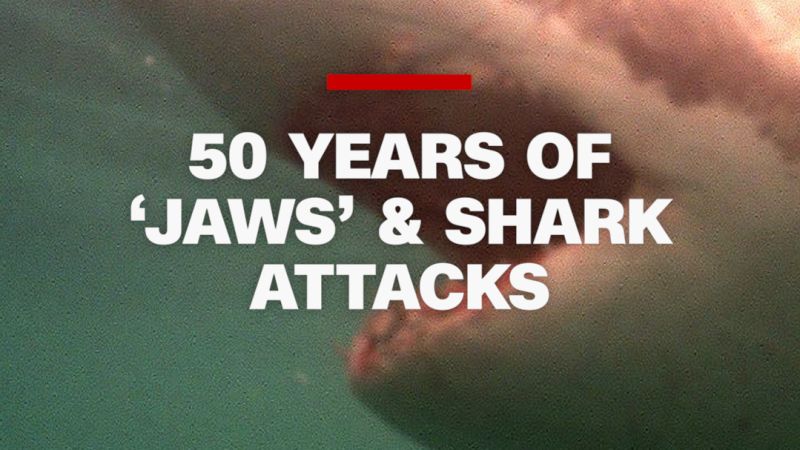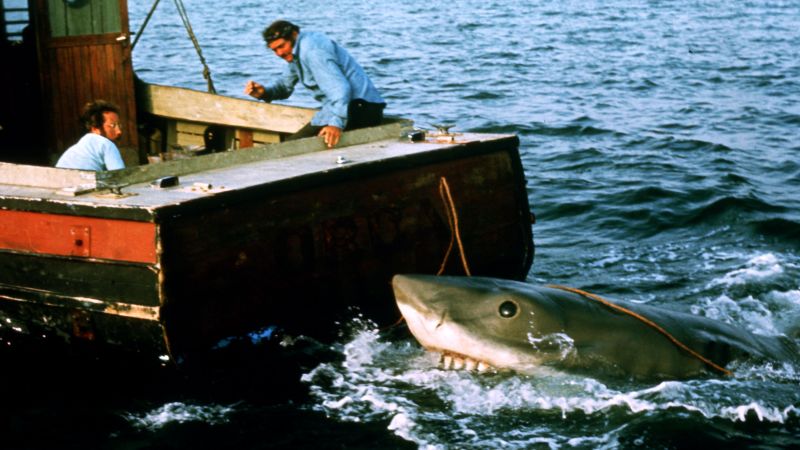Shark Attacks And "Jaws": Fact Vs. Fiction After 50 Years

Welcome to your ultimate source for breaking news, trending updates, and in-depth stories from around the world. Whether it's politics, technology, entertainment, sports, or lifestyle, we bring you real-time updates that keep you informed and ahead of the curve.
Our team works tirelessly to ensure you never miss a moment. From the latest developments in global events to the most talked-about topics on social media, our news platform is designed to deliver accurate and timely information, all in one place.
Stay in the know and join thousands of readers who trust us for reliable, up-to-date content. Explore our expertly curated articles and dive deeper into the stories that matter to you. Visit Best Website now and be part of the conversation. Don't miss out on the headlines that shape our world!
Table of Contents
Shark Attacks and "Jaws": Fact vs. Fiction After 50 Years
This summer marks the 50th anniversary of Steven Spielberg's blockbuster, Jaws. The film, a cultural phenomenon that terrified audiences worldwide and cemented the great white shark's place in popular imagination, also significantly impacted public perception of shark attacks. But how much of the fear it instilled was based on fact, and how much was pure cinematic fiction? Let's dive into the reality of shark attacks and compare it to the dramatic portrayal in Jaws.
The Legacy of Fear: How Jaws Shaped Our Perception of Sharks
Jaws wasn't just a movie; it was a cultural earthquake. Its realistic depiction of a man-eating great white, coupled with Spielberg's masterful suspense, ignited a global "shark frenzy." Beach attendance plummeted, and shark culls increased dramatically. While the film undoubtedly entertained, its impact on the public's understanding of shark behavior and the frequency of attacks was, and continues to be, a subject of ongoing debate.
Fact vs. Fiction: Separating the Hype from the Reality
The film's depiction of a relentless, intelligent, and almost supernatural shark is, thankfully, largely fictional. While great white sharks are apex predators capable of inflicting severe injuries, they don't typically target humans as prey. The reality of shark attacks is far more nuanced:
-
Rarity: The chances of a fatal shark attack are incredibly slim. According to the Florida Museum of Natural History's International Shark Attack File, the annual number of unprovoked shark attacks worldwide is relatively low, typically in the hundreds, with fatalities even fewer. This pales in comparison to the many millions of people who enjoy swimming and surfing in the ocean each year. [Link to International Shark Attack File]
-
Provocation: Many shark attacks are provoked, either accidentally (e.g., a surfer paddling over a shark) or intentionally (e.g., attempting to harm or capture a shark). Understanding shark behavior and respecting their habitat is crucial in minimizing risk.
-
Misidentification: Sometimes, attacks attributed to great white sharks are later determined to have been caused by other shark species, or even other marine animals altogether. Accurate identification is crucial for gathering reliable data.
-
Localized Risk: The risk of a shark attack is not uniformly distributed across the globe. Certain geographical locations, known for specific shark populations and human water activity, experience a higher incidence of attacks than others.
Protecting Sharks and Understanding the Risk:
The lasting legacy of Jaws is a complicated one. While it brought the plight of sharks to the forefront, it simultaneously fostered unfounded fear and contributed to the decimation of shark populations through unnecessary culls. Today, conservation efforts are crucial to protecting these magnificent creatures and maintaining the delicate balance of our oceans. Understanding the true statistics behind shark attacks, distinguishing fact from fiction, and appreciating the vital role sharks play in marine ecosystems is essential to responsible ocean stewardship.
Moving Forward: Responsible Ocean Recreation and Shark Conservation
- Learn about shark behavior: Understanding where and when sharks are most active can significantly reduce your risk.
- Swim in well-lit areas: Avoid swimming at dawn or dusk, when sharks are most active.
- Avoid swimming alone: Swim in groups and stay close to shore.
- Don't wear shiny jewelry: This can attract sharks.
- Support shark conservation efforts: Many organizations work to protect sharks and their habitats. [Link to a relevant shark conservation organization]
Fifty years after Jaws captivated audiences, it’s more important than ever to separate cinematic drama from scientific reality. While the film’s legacy endures, let’s remember that responsible ocean recreation and shark conservation are paramount to ensuring a healthy ocean for both humans and sharks alike.

Thank you for visiting our website, your trusted source for the latest updates and in-depth coverage on Shark Attacks And "Jaws": Fact Vs. Fiction After 50 Years. We're committed to keeping you informed with timely and accurate information to meet your curiosity and needs.
If you have any questions, suggestions, or feedback, we'd love to hear from you. Your insights are valuable to us and help us improve to serve you better. Feel free to reach out through our contact page.
Don't forget to bookmark our website and check back regularly for the latest headlines and trending topics. See you next time, and thank you for being part of our growing community!
Featured Posts
-
 Ex Assistants Testimony Could Decide Sean Diddy Combs Fate
Jun 22, 2025
Ex Assistants Testimony Could Decide Sean Diddy Combs Fate
Jun 22, 2025 -
 Two Days Of 33 C Uk Faces Intense Heatwave
Jun 22, 2025
Two Days Of 33 C Uk Faces Intense Heatwave
Jun 22, 2025 -
 Ex Assistants Testimony Could Be Crucial In Sean Diddy Combs Case
Jun 22, 2025
Ex Assistants Testimony Could Be Crucial In Sean Diddy Combs Case
Jun 22, 2025 -
 50 Years Of Jaws A Legacy Of Fear Fascination And Misunderstood Sharks
Jun 22, 2025
50 Years Of Jaws A Legacy Of Fear Fascination And Misunderstood Sharks
Jun 22, 2025 -
 Mossads Failed Saddam Plot Operation Bramble Bush And Its Deadly Consequences
Jun 22, 2025
Mossads Failed Saddam Plot Operation Bramble Bush And Its Deadly Consequences
Jun 22, 2025
Latest Posts
-
 Post Game Altercation Mlb Reveals Suspensions For Dodgers And Padres Players
Jun 22, 2025
Post Game Altercation Mlb Reveals Suspensions For Dodgers And Padres Players
Jun 22, 2025 -
 Ex Mlb Player Cozart Threatens To Withdraw Trump Support Amid War Concerns
Jun 22, 2025
Ex Mlb Player Cozart Threatens To Withdraw Trump Support Amid War Concerns
Jun 22, 2025 -
 The Deadly Gamble How Operation Bramble Bush Shaped Relations Between Israel Iran And Iraq
Jun 22, 2025
The Deadly Gamble How Operation Bramble Bush Shaped Relations Between Israel Iran And Iraq
Jun 22, 2025 -
 Operation Bramble Bush Israels Secret Mission And Its Devastating Fallout
Jun 22, 2025
Operation Bramble Bush Israels Secret Mission And Its Devastating Fallout
Jun 22, 2025 -
 Assisted Dying A Look At Recent Legal Victories And Ongoing Challenges
Jun 22, 2025
Assisted Dying A Look At Recent Legal Victories And Ongoing Challenges
Jun 22, 2025
